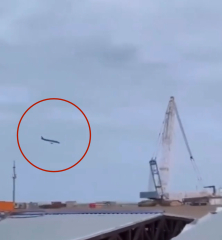One passenger has died onboard a Singapore Airlines flight after the aircraft hit patches of severe turbulence.

On Monday May 20, a Boeing 777-300ER operating Singapore Airlines flight SQ321 between London (LHR) and Singapore (SIN) hit severe turbulence while crossing the Bay of Bengal. Flight tracking data from flightradar24.com suggests that the aircraft 321 dropped 6,000 feet in just a few minutes while passing through the severe turbulence.
28-year-old Dzafram Azmir, a passenger on the flight, recalled, “… very suddenly there was a very dramatic drop so everyone seated and not wearing a seatbelt was launched immediately into the ceiling […] some people hit their heads on the baggage cabins overhead and dented it, they hit the places where lights and masks are and broke straight through it.”
At the time, the Boeing 777-300ER was carrying 211 passengers and 18 crew members onboard.
As a result of the turbulence, the Singapore-bound 777-300ER was forced to divert to Bangkok Suvarnabhumi International Airport (BKK), landing at 15:45 local time.
After the flight landed, it was discovered that one passenger had died aboard fight 321, presumably due to injuries sustained when the flight hit severe turbulence.
"Singapore Airlines offers its deepest condolences to the family of the deceased" stated Singapore Airlines to the BBC after the incident.
Singapore Airlines has said that it was working with Thai authorities to provide medical services to passengers onboard flight SQ321, and that the airline "...was sending a team to Bangkok to provide any additional help needed…"

“I am deeply saddened to learn about the incident onboard Singapore Airlines flight SQ321 from London Heathrow to Singapore…” stated Singapore's Transport Minister Chee Hong Tat. The transport minister later added that the Singaporean government would assist passengers and families who were on board the troubled flight.
What Causes Turbulence?
Most of the time, turbulence is caused when an aircraft experiences a wind current that results in an uneven pressure gradient between the air above and below the wing. Pilots are trained to avoid weather conditions that could cause turbulent conditions. However certain types of turbulence are hard — if not impossible — to predict such as clear air turbulence which is not visible on aircraft weather radars.
Climate change is only expected to exacerbate severe turbulence in the future, with research suggesting that the frequency and severity of clear air turbulence will only increase.

The best way to avoid being injured during periods of severe turbulence is to always have the seatbelt fastened when seated, even if loose. Despite the frequency of severe turbulence increasing, there are still thousands of flights that occur every year without a hitch in the air.
South African Airways Eyes India–South Africa Route » Ethiopian Airlines Expands Fleet with Second Airbus A350-1000 » PHOTOS: Azerbaijan Airlines E190 Crashes in Kazakhstan »
Comments (0)
Add Your Comment
SHARE
TAGS
NEWS Singapore Airlines Boeing Bangkok Turbulence Severe Turbulence Singapore Airlines 777-300ER Diversion IncidentRECENTLY PUBLISHED
 PHOTOS: Azerbaijan Airlines E190 Crashes in Kazakhstan
An Azerbaijan Airlines Embraer E190 crashed approximately 3 km from the city of Aktau today, December 25. Images from the scene show that the aircraft lost speed and then crashed, followed by a large explosion.
NEWS
READ MORE »
PHOTOS: Azerbaijan Airlines E190 Crashes in Kazakhstan
An Azerbaijan Airlines Embraer E190 crashed approximately 3 km from the city of Aktau today, December 25. Images from the scene show that the aircraft lost speed and then crashed, followed by a large explosion.
NEWS
READ MORE »
 South African Airways Eyes India–South Africa Route
As part of its recovery strategy, South African Airways (SAA) is exploring the reinstatement of direct flights between India and South Africa. SAA, along with Minister of Tourism Patricia de Lille, on December 3, 2024, participated in a high-level delegation to India to strengthen aviation and tourism ties between the two nations.
ROUTES
READ MORE »
South African Airways Eyes India–South Africa Route
As part of its recovery strategy, South African Airways (SAA) is exploring the reinstatement of direct flights between India and South Africa. SAA, along with Minister of Tourism Patricia de Lille, on December 3, 2024, participated in a high-level delegation to India to strengthen aviation and tourism ties between the two nations.
ROUTES
READ MORE »
 Ethiopian Airlines Expands Fleet with Second Airbus A350-1000
Ethiopian Airlines, Ethiopia's national carrier, has taken delivery of its second Airbus A350-1000, registered as ET-BAX. This advanced aircraft is powered by Trent XWB-97 engines, further solidifying the airline’s commitment to modernizing its fleet.
NEWS
READ MORE »
Ethiopian Airlines Expands Fleet with Second Airbus A350-1000
Ethiopian Airlines, Ethiopia's national carrier, has taken delivery of its second Airbus A350-1000, registered as ET-BAX. This advanced aircraft is powered by Trent XWB-97 engines, further solidifying the airline’s commitment to modernizing its fleet.
NEWS
READ MORE »





